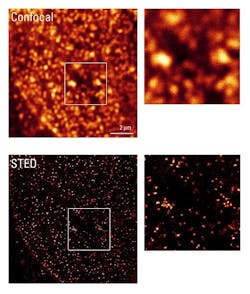Leica super-resolution STED microscopes to incorporate Onefive ultrafast lasers

Ultrafast laser manufacturer Onefive (Zurich, Switzerland) and microscopy systems manufacturer Leica Microsystems (Wetzlar, Germany and Buffalo Grove, IL) have signed an exclusive agreement on a pulsed stimulated emission-depletion (STED) depletion laser at 775 nm that will allow the Leica STED super-resolution microscope to achieve sub-30 nm resolution in a simple and cost-effective manner. Under the terms of the agreement, Onefive will be the exclusive supplier of the STED depletion laser--the Katana-08 HP.
RELATED ARTICLE: New twists on superlenses improve subwavelength microscopy
Onefive will also provide Leica with dual-color single-box excitation lasers. Onefive’s picosecond laser platform Katana-08 HP, which has been available since 2010, has been further streamlined to STED applications to deliver 600 ps pulses to enhance the performance of Leica’s super-resolution microscope system TCS SP8 STED 3X (STED 3X). Operating as a STED beam at 775 nm in a pulsed regime, the Katana-08 HP enables sub-30 nm resolution and can reveal details in multicolor co-localization that have not been visible before as described in Biophysics Journal 105, L01-L03 (2013).
Far-field fluorescence microscopy is a very successful and popular imaging technique because, among other benefits, it is live-cell compatible. Its spatial resolution is however limited to a few hundreds of nanometers by the diffraction-limited nature of light. STED microscopy overcomes this limitation and achieves nano-scale imaging resolution; in fact, this year, Stefan W. Hell of the Max Planck Institute for Biophysical Chemistry will be awarded the prestigious Kavli Prize for his efforts on the development of this technology.
STED microscopy is based on the ability to control the fluorescence emission of the markers in time and space by the superposition of a red-shifted STED laser beam to the excitation beam. The STED beam features a doughnut spatial intensity distribution with a zero-intensity region in the middle. This superimposed beam stimulates an earlier emission of the excited markers. Fluorescence can be practically quenched in regions near the focal point except in the zero-intensity region of the superimposed beam. Because this region can be smaller than the diffraction-limited spot size, the effective spatial extent of the detected spontaneous fluorescence is reduced to sub-diffraction dimensions.
The choice of a Katana-08 pulsed laser as the STED beam instead of a CW beam allows achieving the depletion effect almost instantaneously to excitation, leading to a better spatial confinement of the fluorescence, hence a better on-off switching contrast. The pulsed stimulation reduces the blurring effect typical of CW stimulated emission and leads to better imaging resolution. It has been demonstrated that the performance of the pulsed-depletion modality offers better performance if the pulses are a few hundred picoseconds long.
The picosecond Katana platform offers the versatility of continuously tuning the pulse repetition rate, from pulse on demand up to 120 MHz. Pulse duration can range from sub 20 ps up to 1 ns. Various wavelengths ranging from the near infrared, the visible, to the UV are available. Onefive says its lasers are designed and qualified for 24/7 operation under harsh environments and that a focused product development approach provides a dust-sealed, maintenance-free small footprint product with reliable turn-key operation at a competitive price throughout the complete product fleet.
SOURCE: Onefive; http://www.onefive.com/pdf/Onefive_PressRelease_1stOctober2014.pdf

Gail Overton | Senior Editor (2004-2020)
Gail has more than 30 years of engineering, marketing, product management, and editorial experience in the photonics and optical communications industry. Before joining the staff at Laser Focus World in 2004, she held many product management and product marketing roles in the fiber-optics industry, most notably at Hughes (El Segundo, CA), GTE Labs (Waltham, MA), Corning (Corning, NY), Photon Kinetics (Beaverton, OR), and Newport Corporation (Irvine, CA). During her marketing career, Gail published articles in WDM Solutions and Sensors magazine and traveled internationally to conduct product and sales training. Gail received her BS degree in physics, with an emphasis in optics, from San Diego State University in San Diego, CA in May 1986.